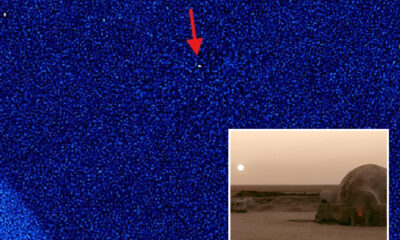Science
Scientists Uncover Hydrogen–Iron Reactions Critical for Water on Exoplanets

Recent research published in the journal Nature has shed light on the formation of water on exoplanets, providing new insights into the potential for life beyond Earth. An international team of scientists conducted a series of laboratory experiments to investigate how interactions between atmospheric hydrogen and magma oceans could produce liquid water on these distant worlds. The findings could have significant implications for identifying viable targets in the search for extraterrestrial life.
To simulate the extreme conditions found on exoplanets, researchers utilized a diamond anvil cell, blasting it with lasers at temperatures reaching 4,000 K (approximately 3,727 degrees Celsius or 6,740 degrees Fahrenheit) and pressures ranging from 16 to 60 gigapascals (GPa). This setup aimed to replicate the interactions between hydrogen-rich atmospheres and iron-rich interiors. In contrast, the average surface temperature of Earth is only 288 K (about 15 degrees Celsius).
The results demonstrated that when a magma ocean rich in hydrogen interacts with iron oxide—effectively reducing it by removing oxygen and transforming it into solid iron—large quantities of water are produced. This finding supports longstanding theories regarding planetary formation and evolution, reinforcing the idea that significant water generation is a natural outcome of these processes.
Dr. Anat Shahar, a staff scientist and deputy for research advancement at the Carnegie Institution for Science, emphasized the importance of these discoveries. “The presence of liquid water is considered critical for planetary habitability,” she remarked. “This work demonstrates that large quantities of water are created as a natural consequence of planet formation. It represents a major step forward in how we think about the search for distant worlds capable of hosting life.”
Identifying Sub-Neptune Exoplanets
The study particularly focused on a category of exoplanets known as sub-Neptunes, which possess masses between those of Earth and Neptune. These planets typically have rocky interiors akin to Earth while also featuring hydrogen-heavy atmospheres similar to Neptune. Approximately 1,000 sub-Neptunes have been identified among the over 6,000 confirmed exoplanets in existence.
Some sub-Neptunes are classified as super-Earths, especially if their mass and radius lean closer to those of Earth. Notable examples of exoplanets with hydrogen-rich atmospheres that orbit within or near their star’s habitable zone include K2-18 b, located about 124 light-years from Earth, Kepler-138 d at 218 light-years, and TOI-270 d at 73 light-years.
These exoplanets orbit M-dwarf stars, which are smaller and cooler than our Sun. Consequently, their habitable zones are also smaller. Despite this, M-dwarf stars have much longer lifetimes than larger stars like the Sun, estimated in the range of trillions of years compared to the Sun’s approximate 10 billion years.
Implications for Future Research
The findings from this study highlight that while astronomers have traditionally sought exoplanets resembling Earth, those that differ significantly from our solar system may also exhibit conditions conducive to life. This research opens new avenues for understanding the potential prevalence of water on exoplanets, suggesting it may be more common than previously assumed.
As scientists continue to explore the implications of these findings, the potential for discovering habitable exoplanets grows. The study serves as a reminder of the complexities involved in planetary formation and the varied environments that could support life. Future research will undoubtedly delve deeper into the processes that lead to water production on exoplanets, enhancing our understanding of the universe and the possibility of life beyond our planet.
-

 Technology5 months ago
Technology5 months agoDiscover the Top 10 Calorie Counting Apps of 2025
-

 Technology2 weeks ago
Technology2 weeks agoOpenAI to Implement Age Verification for ChatGPT by December 2025
-

 Health3 months ago
Health3 months agoBella Hadid Shares Health Update After Treatment for Lyme Disease
-

 Health3 months ago
Health3 months agoAnalysts Project Stronger Growth for Apple’s iPhone 17 Lineup
-

 Health3 months ago
Health3 months agoErin Bates Shares Recovery Update Following Sepsis Complications
-

 Technology5 months ago
Technology5 months agoDiscover How to Reverse Image Search Using ChatGPT Effortlessly
-

 Technology3 months ago
Technology3 months agoElectric Moto Influencer Surronster Arrested in Tijuana
-

 Technology2 months ago
Technology2 months agoDiscover 2025’s Top GPUs for Exceptional 4K Gaming Performance
-

 Technology5 months ago
Technology5 months agoMeta Initiates $60B AI Data Center Expansion, Starting in Ohio
-

 Technology5 months ago
Technology5 months agoRecovering a Suspended TikTok Account: A Step-by-Step Guide
-

 Health5 months ago
Health5 months agoTested: Rab Firewall Mountain Jacket Survives Harsh Conditions
-

 Lifestyle5 months ago
Lifestyle5 months agoBelton Family Reunites After Daughter Survives Hill Country Floods





















